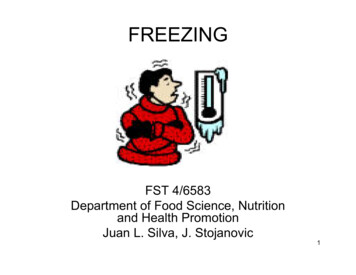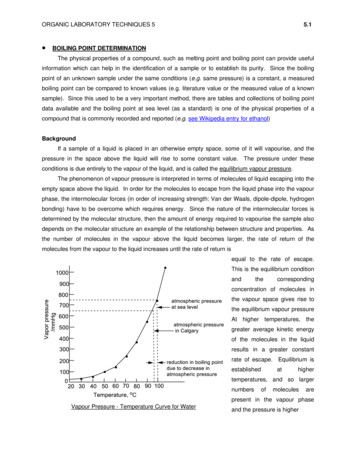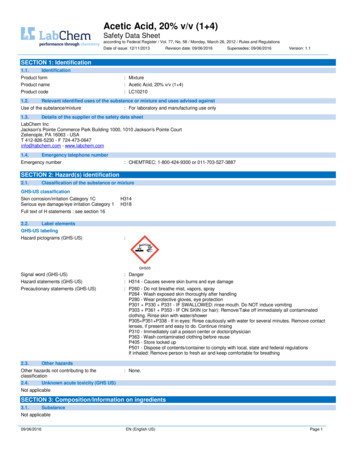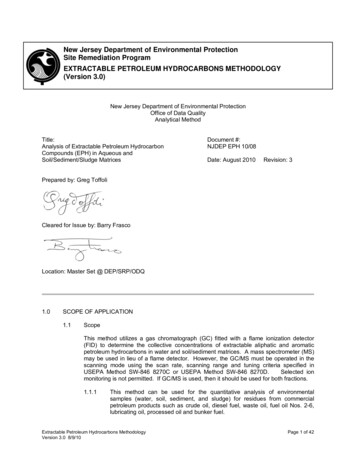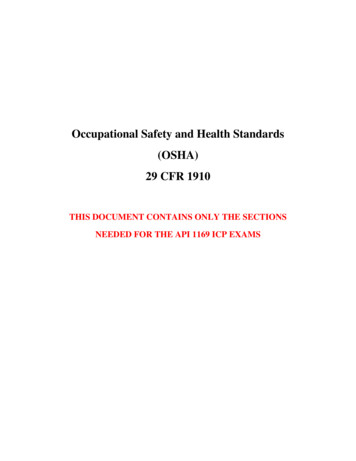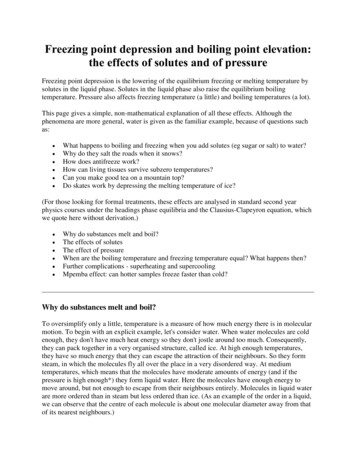
Transcription
Freezing point depression and boiling point elevation:the effects of solutes and of pressureFreezing point depression is the lowering of the equilibrium freezing or melting temperature bysolutes in the liquid phase. Solutes in the liquid phase also raise the equilibrium boilingtemperature. Pressure also affects freezing temperature (a little) and boiling temperatures (a lot).This page gives a simple, non-mathematical explanation of all these effects. Although thephenomena are more general, water is given as the familiar example, because of questions suchas: What happens to boiling and freezing when you add solutes (eg sugar or salt) to water?Why do they salt the roads when it snows?How does antifreeze work?How can living tissues survive subzero temperatures?Can you make good tea on a mountain top?Do skates work by depressing the melting temperature of ice?(For those looking for formal treatments, these effects are analysed in standard second yearphysics courses under the headings phase equilibria and the Clausius-Clapeyron equation, whichwe quote here without derivation.) Why do substances melt and boil?The effects of solutesThe effect of pressureWhen are the boiling temperature and freezing temperature equal? What happens then?Further complications - superheating and supercoolingMpemba effect: can hotter samples freeze faster than cold?Why do substances melt and boil?To oversimplify only a little, temperature is a measure of how much energy there is in molecularmotion. To begin with an explicit example, let's consider water. When water molecules are coldenough, they don't have much heat energy so they don't jostle around too much. Consequently,they can pack together in a very organised structure, called ice. At high enough temperatures,they have so much energy that they can escape the attraction of their neighbours. So they formsteam, in which the molecules fly all over the place in a very disordered way. At mediumtemperatures, which means that the molecules have moderate amounts of energy (and if thepressure is high enough*) they form liquid water. Here the molecules have enough energy tomove around, but not enough to escape from their neighbours entirely. Molecules in liquid waterare more ordered than in steam but less ordered than ice. (As an example of the order in a liquid,we can observe that the centre of each molecule is about one molecular diameter away from thatof its nearest neighbours.)
Why is the change so sudden? At atmospheric pressure, water melts at 0 C and boils at 100 C.What determines the melting point and the boiling point?The answer is a trade-off between the molecular energy (which we notice as temperature) andthe molecular order: the difference between highly organised structure in ice, rather closepacking in liquid water, and nearly complete disorganisation in steam. At 0 C and 100 C, theorder effect and the energy effect are exactly balanced, and so ice and water co-exist at 0 C,water and steam coexist at 100 C (at atmospheric pressure).The crystalline structure of ice is rather difficult to show in two dimensions, so thesketches below show, schematically, a simpler crystal, liquid and vapour phase. Thepatterened circles represent simplistically the substance in whose melting and evaporationwe are interested. The coloured circles represent molecules of the air, which is mainlynitrogen. The black circles (next picture) represent solutes. The sketches are not to scale.The effects of solutesWhat happens if, instead of having pure liquid water, we put some salt or sugar in the water? Inother words, what if our liquid phase is a solution? This makes the liquid state less organised,because the sugar molecules or salt ions are free to move about almost randomly. So the liquidwater molecules are more disordered (less regimented) in a solution. The ice and the steamremain unaffected, however: sugar and salt hardly dissolve at all in ice, nor do they evaporatenear 100 C.How does this affect the trade-off between the molecular energy and the molecular order? Thegain in disorder on evaporation is now less, because the liquid water in solution is moredisordered. The energy effect is hardly changed, so the energy effect now dominates over a
slightly larger range: the molecules of water in solution have to have slightly more energy (aslightly higher temperature) in order for the two effects to be in balance. So the boilingtemperature is higher for a solution.Conversely, when we look at melting, the disorder effect is greater for a solution: on melting intoa solution, water molecules go from the high order of crystalline ice into an even moredisordered state than pure liquid. So the disorder effect can dominate even at lower temperatures.So the freezing temperature is lower for a solution.I mentioned the equilibrium freezing and boiling temperatures above. Time to explain. Imagineice floating in pure water at 0 C. If we add a little heat, some ice melts. Remove a little heat andsome water freezes. We call this the equilibrium freezing temperature: 0 C for water. However,when one cools reasonably pure water, it usually cools several degrees below 0 C – we say itsupercools by several degrees – before the first ice crystal appears. That ice crystal then expandsrapidly, giving up latent heat, which warms the nearby water back to about 0 C. More aboutsupercooling and super heating below.An aqueous solution has a higher boiling point and a lower freezing point thandoes pure water.If the solution is not too concentrated, these two effects are approximately independent of whatthe dissolved substance is: a sugar molecule has much the same effect as a salt ion. So, providedyou remember to count each ion separately, the effect of concentration on boiling point elevationor freezing point depression is much the same for all small solutes in water. (Macromoleculessuch as polymers behave differently because they have lots of neighbouring solvent molecules,and so affect the solvent much more than simple solutes.)Antifreeze. So, you might expect that the antifreeze in a radiator not only stops it freezing, butalso helps stop it from boiling. However, the real situation is more complicated: antifreeze hasthe disadvantage that it is not quite as good as water at transporting heat. Ethylene glycol is oneantifreeze. Salt is used to melt snow and ice on roads in cold countries, but it is not used inradiators because it is corrosive and crystallises readily. Sugar is not used in some applications,because concentrated sugar solutions are viscous, and because they support bugs. However,many organisms use sugars and other small organic molecules as antifreeze. See cryobiology.An interesting observation: The concentration of solutes in blood is less than that in sea water, sothe equilibrium freezing temperature of blood is usually higher than that of sea water.Consequently, some Arctic and Antarctic fish live at temperatures below the equilibriumfreezing temperature of normal blood. The bio-antifreeze in their blood is a protein that works ina way different from the anti-freeze used in car radiators: the antifreeze protein binds to freezingnuclei and so permits the blood to remain supercooled.The effect of pressureNotice that above I've included the proviso "at atmospheric pressure" a few times. The reasonwhy the pressure is important is that, in the vapour phase, a given amount of a substance
occupies a much larger volume than it does as a liquid. Some of the energy required to vapouriseit goes towards 'pushing the air out of the way' to make room for the amount evaporated. (Theamount of work done is the product of the pressure P and the change in volume ΔV. Technically,there is a PΔV term in the latent heat.) So, at low pressure, it is easier to form the vapour phaseand so the boiling point is lower. The dependence of the transition temperature on pressure is theClausius-Clapeyron effect. (Again, being a bit technical, we note that this effect involves energy- the work done in displacing air - whereas the solute effect involves entropy - the disordering ofthe liquid phase.)Water expands a lot when it boils: one kilogram of water is one litre of liquid water, but itbecomes about 1700 litres of steam at atmospheric pressure. This means that even modestincreases in altitude can measurably reduce the boiling temperature. Some people complain thatthis affects cooking and even the taste of tea at altitude.It is also true that pressure changes the melting temperature. However, because the volumeoccupied by a kilogram of liquid is not much different from that occupied by a kilogram of solid,this effect is very small unless the pressures are very large. For most substances, the freezingpoint rises, though only very slightly, with increased pressure.Water is one of the very rare substances that expands upon freezing (which is why ice floats).Consequently, its melting temperature falls very slightly if pressure is increased.It is sometimes said that freezing point depression with pressure explains the low friction under an iceskate. On its own, this story is not convincing. The Clausius-Clapeyron effect appears not large enough tomake a noticeable difference. However, the skate story is so widely believed (outside of thermodynamicsclasses, anyway) that it's worth being quantitative. The Clausius-Clapeyron equation says that the ratio ofthe change in pressure times the change in specific volume to the latent heat of the phase change equals theratio of the change in transition temperature to the (absolute) melting or boiling temperature. (It's oftenwritten as dP/dT L/T*Δv, an equation that we might have guessed from dimensional considerations.)The weight of the skater is say 1 kN. I'm not a skater, but let me guess at a lower bound for the skate-icecontact area of say 100 mm2. (Say 200 mm long by 0.5 mm wide: skaters, is this reasonable?) So, with thisvalue, the pressure is increased by (very roughly) 10 MPa. A kg of water (one litre) freezes to give about1.1 litre of ice, so the change in specific volume is about 10 -4 m3kg-1. The latent heat of fusion of ice is330 kJ.kg-1. So the proportional change in temperature is (10 MPa)(10-4 m3kg-1)/(330 kJ.kg-1), which is0.3%. Multiply this by the melting temperature of ice (273 K) and we get an upper bound to thetemperature change of around 1 K 1 C. So, with these values, the calculation shows that the pressure ofan ice skate can reduce themelting temperature of ice by more than 1 C. So, if this were the cause of theslipperiness, ice skating would be possible only at temperatures only one or a few degrees below freezing.From observation, it is possible to ice skate on ice at much lower temperatures than this. Unless we couldargue that the area of contact of a skate is as small as 10 mm2, this effect cannot explain why ice is slipperyunder a skate. On the other hand, it is easy to explain that the surface of ice is at least a little slippery. Atthe surface of ice, water molecules are only hydrogen bonded to their neighbours on one side.Consequently, their energy is not as low as in bulk ice. So, at equilibrium, they must have a higher entropy.So ice must have a thin water layer on the surface, whose thickness woud be expected to increase attemperatures close to melting.The comparable calculation for boiling point change is a bit more complicated. The latent heat in this caseis larger (2.3 MJ-1) but the change in specific volume is much larger (typically a few times 10 -2 m3kg-1). Sochanges in altitude can change the boiling temperature, and going up a mountain can reduce it by as much
as several degrees.When are the boiling temperature and freezing temperature equal? Whathappens then?For all substances, as we lower pressure, the boiling temperature falls much more rapidly thandoes the freezing temperature. (For water, the freezing temperature rises slightly at lowpressure.) Hence the obvious question: Are the boiling temperature and freezing temperatureever equal?The answer is yes. At the low pressure of 611 Pa (only 0.006 times atmospheric pressure), purewater boils at 0.01 C, and it also freezes at 0.01 C. The combination of conditions (P, T) (611 Pa, 0.01 C) is called thetriple point of water because, at this pressure and temperature ice,liquid water and steam can coexist in equilibrium. This point is used to define our scale oftemperature: by definition, the triple point of water occurs at 273.16 K, where K is the kelvin.273.16 K 0.01 C* This explains why, above, I wrote that liquid water only exists if the pressure is high enough.At pressures below 611 Pa, there are only two phases, and ice sublimes to form steam directly,without passing through a liquid phase. (In this context, the reverse of 'to sublime' is not, as onemight have hoped, 'to ridicule'. At low pressures, steam condenses to form ice.)Further complications - non-equilibriumphasesI've made a simplification above and it's time to look atit. At atmospheric pressure, pure water does not alwaysboil at 100 C nor freeze at 0 C. Superheating is theterm for raising the temperature of a liquid above itsequilibrium boiling point. I have a page on superheatingin microwave ovens because it is so dangerous.Supercooling occurs when a liquid is cooled below itsequilibrium freezing temperature. For example, watercan sometimes be cooled as much as a few tens ofdegrees below 0 C without freezing. This phenomenonis important in cryobiology. See also What is'unfreezable water'?Cryobiology links Introduction to cellular cryobiology and some of our research in this area.Membranes: homeostasis and regulation of area and tension, and how thisrelates to survival of freeze-thaw cycles.
Freezing in alpine forests. A collaborative study with Marilyn Ball of ANU.What is 'unfreezable water'?. A FAQ in cryobiology and anhydrobiology.What the Hydration Forces Explanation doesn't say. A warning about someprevalent misquotations in cellular cryobiology.Society for Cryobiology. The scientific society in this field.CryoLetters, the rapid communication journal in the vation.htm
Water is one of the very rare substances that expands upon freezing (which is why ice floats). Consequently, its melting temperature falls very slightly if pressure is increased. It is sometimes said that freezing point depression with pressure explains the low friction under an ice-

